Joint Application of Fractal Analysis and Weights-of-Evidence Method for Revealing the Geological Controls on Regional-Scale Tungsten Mineralization in Southern Jiangxi Province, China
Abstract
:1. Introduction
2. Materials and Methods
2.1. Study Area and Input Data
2.2. Box-Counting Fractal Analysis
2.3. Weights of Evidence Method
3. Results and Discussion
3.1. Selection of Ore-Related Faults
3.2. Fractal Characteristics of Geological Features
3.3. Quantitative Measurement of Spatial Association and Implications for Further Prospectivity
3.3.1. Determination of Buffer Range
3.3.2. Structure
3.3.3. Granites
3.3.4. Geophysical Anomalies
3.3.5. Geochemical Anomalies
3.4. Predictive Targets Delineated by Combined Fractal and WofE Results
- Prospectivity I: zones delineated by high posterior probabilities in combination with high fractal dimension of faults and high fractal dimension of fault intersections. Ten Level I zones are extracted and filled with cross lines in Figure 11. A total of 70 tungsten occurrences, occupying 58.47% of all the occurrences in the SJP, fall within or proximal (<3 km) to these zones. The occurrence density of level-I zones reaches a value of 0.0325/km2 compared with a background value of 0.0025/km2. It is inferred that Zones I-4, I-5, and I-7 containing no occurrence at present have great potential of prospectivity and can be considered as the most favorable targets in future exploration.
- Prospectivity II: zones with high posterior probabilities excluding Level I zones. A total of 25 tungsten occurrences are included in these zones, reaching an occurrence density of 0.0078/km2 which is three times the value of background. Level II zones have good prospective potential and are considered as favorable targets in future exploration.
- Background: zones with intermediate to low posterior probability. Twenty mineral occurrences are located in zones with intermediate posterior probability, accounting for an occurrence density of 0.0016/km2. The remaining 4 occurrences are situated in zones with low posterior probability. These zones should not be considered for exploratory targeting.
4. Conclusions
Acknowledgments
Author Contributions
Conflicts of Interest
References
- Zhao, C.B.; Hobbs, B.E.; Ord, A. Fundamentals of Computational Geoscience: Numerical Methods and Algorithms; Springer: Berlin, Germany, 2009; pp. 1–26. [Google Scholar]
- Liu, L.M.; Wan, C.L.; Zhao, C.B.; Zhao, Y.L. Geodynamic constraints on orebody localization in the Anqing orefield, China: Computational modeling and facilitating predictive exploration of deep deposits. Ore Geol. Rev. 2011, 43, 249–263. [Google Scholar] [CrossRef]
- Haddad-Martim, P.M.; Filho, C.R.D.S.; Carranza, E.J.M. Spatial analysis of mineral deposit distribution: A review of methods and implications for structural controls on iron oxide-copper-gold mineralization in Carajás, Brazil. Ore Geol. Rev. 2017, 81, 230–244. [Google Scholar] [CrossRef]
- Li, X.H.; Yuan, F.; Zhang, M.M.; Jia, C.; Jowitt, S.M.; Ord, A.; Zheng, T.K.; Hu, X.Y.; Li, Y. Three-dimensional mineral prospectivity modeling for targeting of concealed mineralization within the Zhonggu iron orefield, Ningwu Basin, China. Ore Geol. Rev. 2015, 71, 633–654. [Google Scholar] [CrossRef]
- Prasad, J.; Venkatesh, A.S.; Sahoo, P.R.; Singh, S.; Kanouo, N.S. Geological controls on high-grade iron ores from Kiriburu-Meghahatuburu Iron Ore Deposit, Singhbhum-Orissa Craton, Eastern India. Minerals 2017, 7, 197. [Google Scholar] [CrossRef]
- Thiergärtner, H. Theory and Practice in Mathematical Geology—Introduction and Discussion. Math. Geol. 2006, 38, 659–665. [Google Scholar] [CrossRef]
- Manuel, R.; Brito, M.; Chichorro, M.; Rosa, C. Remote Sensing for Mineral Exploration in Central Portugal. Minerals 2017, 7, 184. [Google Scholar] [CrossRef]
- Castañón, C.; Arias, D.; Diego, I.; Martin-lzard, A.; Ruiz, Y. Minerals Resource and Reserve Calculation in Seam-Shaped Mineral Deposits; A New Approach: “The Pentahedral Method”. Minerals 2017, 7, 72. [Google Scholar] [CrossRef]
- Guo, J.T.; Wu, L.X.; Zhou, W.H.; Jiang, J.Z.; Li, C.L. Towards Automatic and Topologically Consistent 3D Regional Geological Modeling from Boundaries and Attitudes. ISPRS Int. J. Geo-Inf. 2016, 5, 17. [Google Scholar] [CrossRef]
- Cheng, Q.M. Non-Linear Theory and Power-Law Models for Information Integration and Mineral Resources Quantitative Assessments. Math. Geosci. 2008, 40, 503–532. [Google Scholar] [CrossRef]
- Sun, T.; Liu, L.M. Delineating the complexity of Cu–Mo mineralization in a porphyry intrusion by computational and fractal modeling: A case study of the Chehugou deposit in the Chifeng district, Inner Mongolia, China. J. Geochem. Explor. 2014, 144, 128–143. [Google Scholar] [CrossRef]
- Mandelbrot, B.B. Fractals: Form, Chances and Dimension; W.H. Freeman: New York, NY, USA, 1977; pp. 1–23. [Google Scholar]
- Carranza, E.J.M. Controls on mineral deposit occurrence inferred from analysis of their spatial pattern and spatial association with geological features. Ore Geol. Rev. 2009, 35, 383–400. [Google Scholar] [CrossRef]
- Carranza, E.J.M.; Owusu, E.A.; Hale, M. Mapping of prospectivity and estimation of number of undiscovered prospects for lode gold, southwestern Ashanti Belt, Ghana. Miner. Depos. 2009, 44, 915–938. [Google Scholar] [CrossRef]
- Gumiel, P.; Sanderson, D.J.; Arias, M.; Roberts, S.; Martín-lzard, A. Analysis of the fractal clustering of ore deposits in the Spanish Iberian Pyrite Belt. Ore Geol. Rev. 2010, 38, 307–318. [Google Scholar] [CrossRef]
- Zhao, J.N.; Chen, S.Y.; Zuo, R.G.; Carranza, E.J.M. Mapping complexity of spatial distribution of faults using fractal and multifractal models: Vectoring towards exploration targets. Comput. Geosci. 2011, 37, 1958–1966. [Google Scholar] [CrossRef]
- Kruhl, J.H. Fractal-geometry techniques in the quantification of complex rock structures: A special view on scaling regimes, inhomogeneity and anisotropy. J. Struct. Geol. 2013, 46, 2–21. [Google Scholar] [CrossRef]
- Cheng, Q.M.; Agterberg, F.P.; Ballantyne, S.B. The separation of geochemical anomalies from background by fractal methods. J. Geochem. Explor. 1994, 51, 109–130. [Google Scholar] [CrossRef]
- Zuo, R.G.; Wang, J. Fractal/multifractal modeling of geochemical data: A review. J. Geochem. Explor. 2016, 164, 33–41. [Google Scholar] [CrossRef]
- Roberts, S.; Sanderson, D.J.; Gumiel, P. Fractal analysis of Sn-W mineralization from central Iberia; insights into the role of fracture connectivity in the formation of an ore deposit. Econ. Geol. 1998, 93, 360–365. [Google Scholar] [CrossRef]
- Afzal, P.; Alghalandis, Y.F.; Khakzad, A.; Moarefvand, P.; Omran, N.R. Delineation of mineralization zones in porphyry Cu deposits by fractal concentration–volume modeling. J. Geochem. Explor. 2011, 108, 220–232. [Google Scholar] [CrossRef]
- Agterberg, F.P. Fractals and Spatial Statistics of Point Patterns. J. Earth Sci. 2013, 24, 1–11. [Google Scholar] [CrossRef]
- Chen, G.X.; Liu, T.Y.; Sun, J.S.; Cheng, Q.M.; Sahoo, B.; Zhang, Z.J.; Zhang, H.L. Gravity method for investigating the geological structures associated with W-Sn polymetallic deposits in the Nanling Range, China. J. Appl. Geophys. 2015, 120, 14–25. [Google Scholar] [CrossRef]
- Mirzaie, A.; Bafti, S.S.; Derakhshani, R. Fault control on Cu mineralization in the Kerman porphyry copper belt, SE Iran: A fractal analysis. Ore Geol. Rev. 2015, 71, 237–247. [Google Scholar] [CrossRef]
- Zuo, R.G.; Cheng, Q.M.; Xia, Q.L. Application of fractal models to characterization of vertical distribution of geochemical element concentration. J. Geochem. Explor. 2009, 102, 37–43. [Google Scholar] [CrossRef]
- Ford, A.; Blenkinsop, T.G. Combining fractal analysis of mineral deposit clustering with weights of evidence to evaluate patterns of mineralization: Application to copper deposits of the Mount Isa Inlier, NW Queensland, Australia. Ore Geol. Rev. 2008, 33, 435–450. [Google Scholar] [CrossRef]
- Cheng, Q.M.; Agterberg, F.P. Fuzzy Weights of Evidence Method and Its Application in Mineral Potential Mapping. Nat. Resour. Res. 1999, 8, 27–35. [Google Scholar] [CrossRef]
- Joly, A.; Porwal, A.; Mccuaig, T.C. Exploration targeting for orogenic gold deposits in the Granites-Tanami Orogen: Mineral system analysis, targeting model and prospectivity analysis. Ore Geol. Rev. 2012, 48, 349–383. [Google Scholar] [CrossRef]
- Yuan, F.; Li, X.H.; Zhang, M.M.; Jowitt, S.M.; Jia, C.; Zheng, T.K.; Zhou, T.F. Three-dimensional weights of evidence-based prospectivity modeling: A case study of the Baixiangshan mining area, Ningwu Basin, Middle and Lower Yangtze Metallogenic Belt, China. J. Geochem. Explor. 2014, 145, 82–97. [Google Scholar] [CrossRef]
- Sang, X.J.; Xue, L.F.; Liu, J.W.; Zhan, L. A Novel Workflow for Geothermal Prospectively Mapping Weights-of-Evidence in Liaoning Province, Northeast China. Energies 2017, 10, 1069. [Google Scholar] [CrossRef]
- Wang, C.B.; Rao, J.F.; Chen, J.G.; Ouyang, Y.P.; Qi, S.J.; Li, Q. Prospectivity Mapping for “Zhuxi-type” Copper-Tungsten Polymetallic Deposits in the Jingdezhen Region of Jiangxi Province, South China. Ore Geol. Rev. 2017, 89, 1–14. [Google Scholar] [CrossRef]
- Xu, J.X.; Zeng, Z.L.; Wang, D.H.; Chen, Z.H.; Liu, S.B.; Wang, C.H.; Ying, L.J. A new type of tungsten deposit in Southern Jiangxi and the new model of “five floors + basement” for prospecting. Acta Geol. Sin. 2007, 82, 880–887. [Google Scholar]
- Fang, G.C.; Chen, Z.H.; Chen, Y.H.; Li, J.G.; Zhao, B.; Zhou, X.P.; Zeng, Z.L.; Zhang, Y.Z. Geophysical investigation of the geology and structure of the Pangushan-Tieshanlong tungsten ore field, South Jiangxi, China-Evidence for site-selection of the 2000-m Nanling Scientific Drilling Project (SP-NLSD-2). J. Asian Earth Sci. 2015, 110, 10–18. [Google Scholar] [CrossRef]
- Mao, J.W.; Xie, G.Q.; Guo, C.L.; Chen, Y.C. Large-scale tungsten-tin mineralization in the Nanling region, South China: Metallogenic ages and corresponding geodynamic processes. Acta Petrol. Sin. 2007, 23, 2329–2338. [Google Scholar]
- Feng, C.Y.; Zeng, Z.L.; Zhang, D.Q.; Qu, W.J.; Du, A.D.; Li, D.X.; She, H.Q. SHRIMP zircon U–Pb and molybdenite Re–Os isotopic dating of the tungsten deposits in the Tianmenshan–Hongtaoling W–Sn orefield, southern Jiangxi Province, China, and geological implications. Ore Geol. Rev. 2011, 43, 8–25. [Google Scholar] [CrossRef]
- Mao, J.W.; Cheng, Y.B.; Chen, M.H.; Pirajno, F. Major types of time-space distribution of Mesozoic ore deposits in South China and their geodynamic settings. Miner. Depos. 2013, 48, 267–294. [Google Scholar]
- Wang, Y.J.; Fan, W.M.; Peng, T.P.; Guo, F. Elemental and Sr–Nd isotopic systematics of the early Mesozoic volcanic sequence in southern Jiangxi Province, South China: Petrogenesis and tectonic implications. Int. J. Earth Sci. 2005, 94, 53–65. [Google Scholar] [CrossRef]
- Yang, J.H.; Peng, J.T.; Zhao, J.H.; Fu, Y.Z.; Chen, Y.; Hong, Y.L. Petrogenesis of the Xihuashan Granite in Southern Jiangxi Province, South China:Constraints from Zircon U-Pb Geochronology, Geochemistry and Nd Isotopes. Acta Geol. Sin. 2012, 86, 131–152. [Google Scholar]
- Chen, G.X.; Cheng, Q.M.; Zuo, R.G.; Liu, T.Y.; Xi, Y.F. Identifying gravity anomalies caused by granitic intrusions in Nanling mineral district, China: A multifractal perspective. Geophys. Prospect. 2015, 63, 256–270. [Google Scholar] [CrossRef]
- Yang, J.H.; Peng, J.T.; Hu, R.Z.; Bi, X.W.; Zhao, J.H.; Fu, Y.Z.; Shen, N.P. Garnet geochemistry of tungsten-mineralized Xihuashan granites in South China. Lithos 2013, 177, 79–90. [Google Scholar] [CrossRef]
- National Geological Archives of China. Available online: http://en.ngac.org.cn (accessed on 26 October 2017).
- Bonham-Carter, G.F. Geographic Information System for Geoscientists, Modeling with GIS; Pergamon: New York, NY, USA, 1994; pp. 238–333. [Google Scholar]
- Agterberg, F.P.; Bonham-Carter, G.F.; Wrigh, D.F. Statistical pattern integration for mineral exploration. In Computer Application in Resource Estimation Prediction and Assessment for Metals and Petroleum; Gaal, G., Merriam, D.F., Eds.; Pergamon: New York, NY, USA, 1990; pp. 1–21. [Google Scholar]
- Allek, K.; Boubaya, D.; Bouguern, A.; Hamoudi, M. Spatial association analysis between hydrocarbon fields and sedimentary residual magnetic anomalies using Weights of Evidence: An example from the Triassic Province of Algeria. J. Appl. Geophys. 2016, 135, 100–110. [Google Scholar] [CrossRef]
- Zeng, H.L.; Zhang, Q.H.; Li, Y.S.; Liu, J. Crustal structure inferred from gravity anomalies in South China. Tectonophysics 1997, 283, 189–203. [Google Scholar] [CrossRef]
- China Ministry of Geology and Mineral Resources. Study on Regional Tectonic Characteristics and Ore-forming Structures in the Nanling Range; Geological Publishing House: Beijing, China, 1988; pp. 1–198. (In Chinese) [Google Scholar]
- Jiangxi Bureau of Geology and Mineral Resources. Mineral Prospecting and Targeting of W-Sn-Pb-Zn Deposits in Southern Jiangxi Province; Jiangxi Bureau of Geology and Mineral Resources: Nanchang, China, 2002; pp. 28–30. (In Chinese)
- Chen, X.Q.; Fu, J.M. Geochemical Maps of Nanling Range; China University of Geoscience Press: Wuhan, China, 2012; pp. 1–88. (In Chinese) [Google Scholar]
- Lecumberri-Sanchez, P.; Vieira, R.; Heinrich, C.A.; Pinto, F.; Wälle, M. Fluid-rock interaction is decisive for the formation of tungsten deposits. Geology 2017, 45, 579–582. [Google Scholar] [CrossRef]
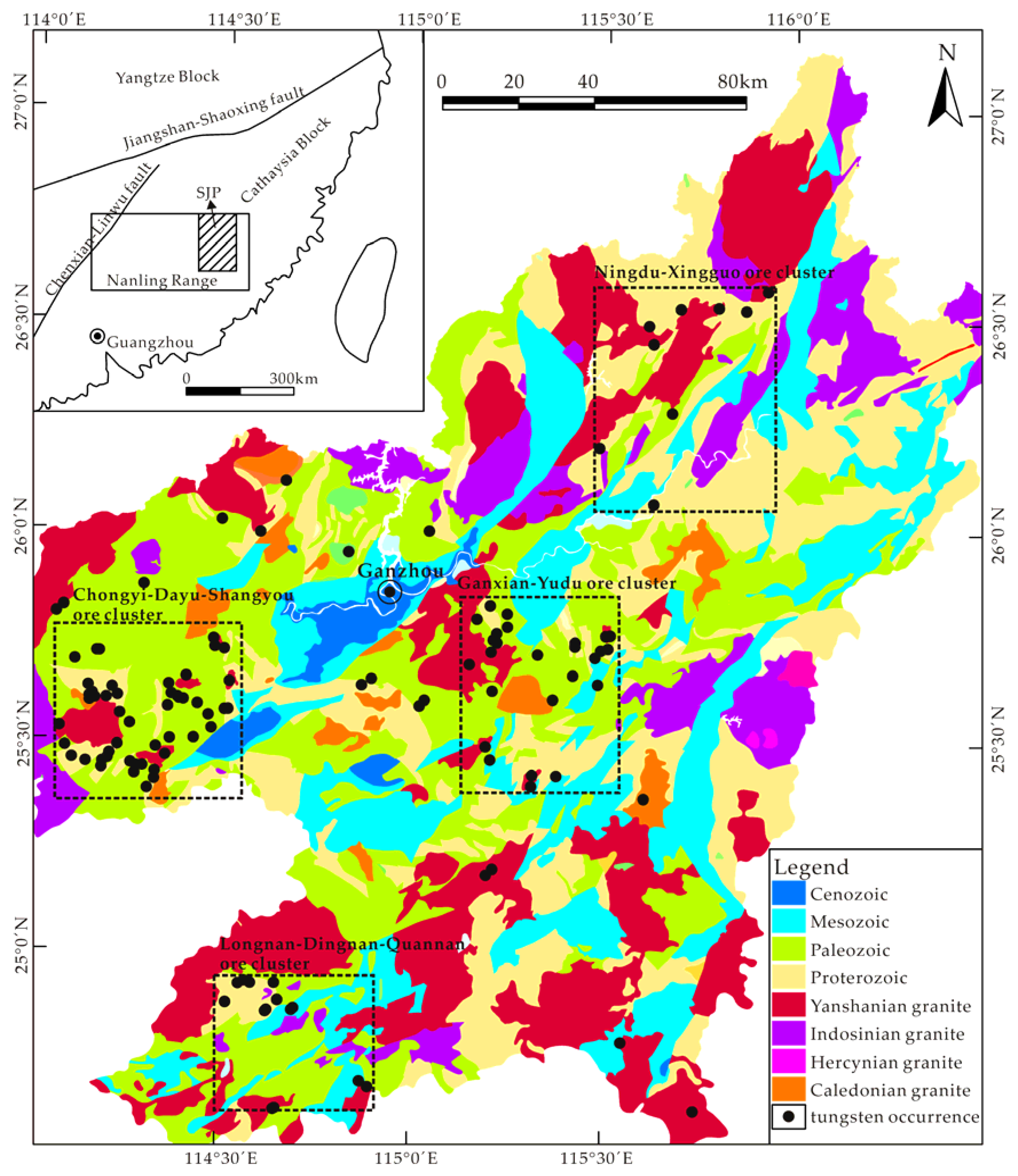
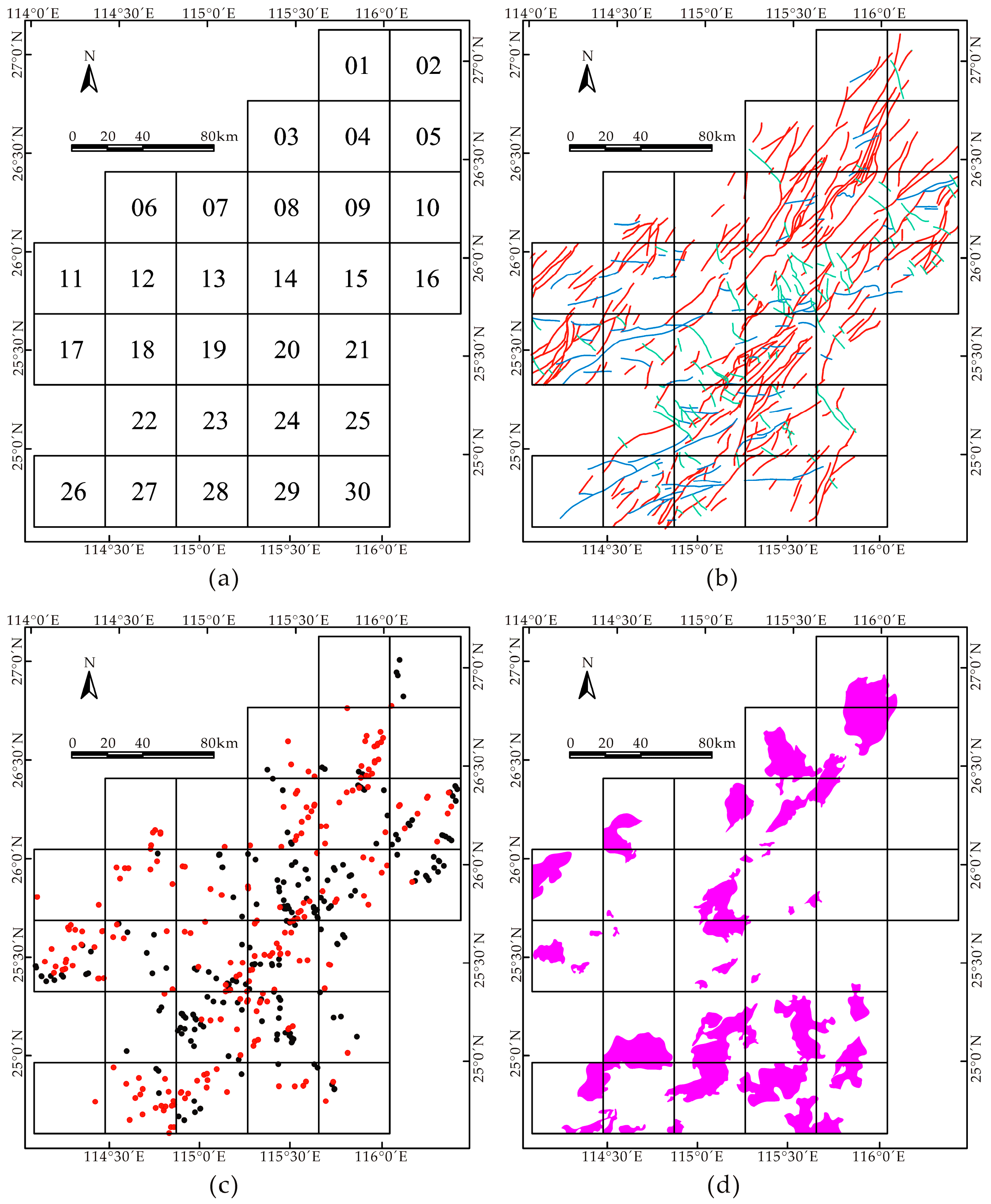

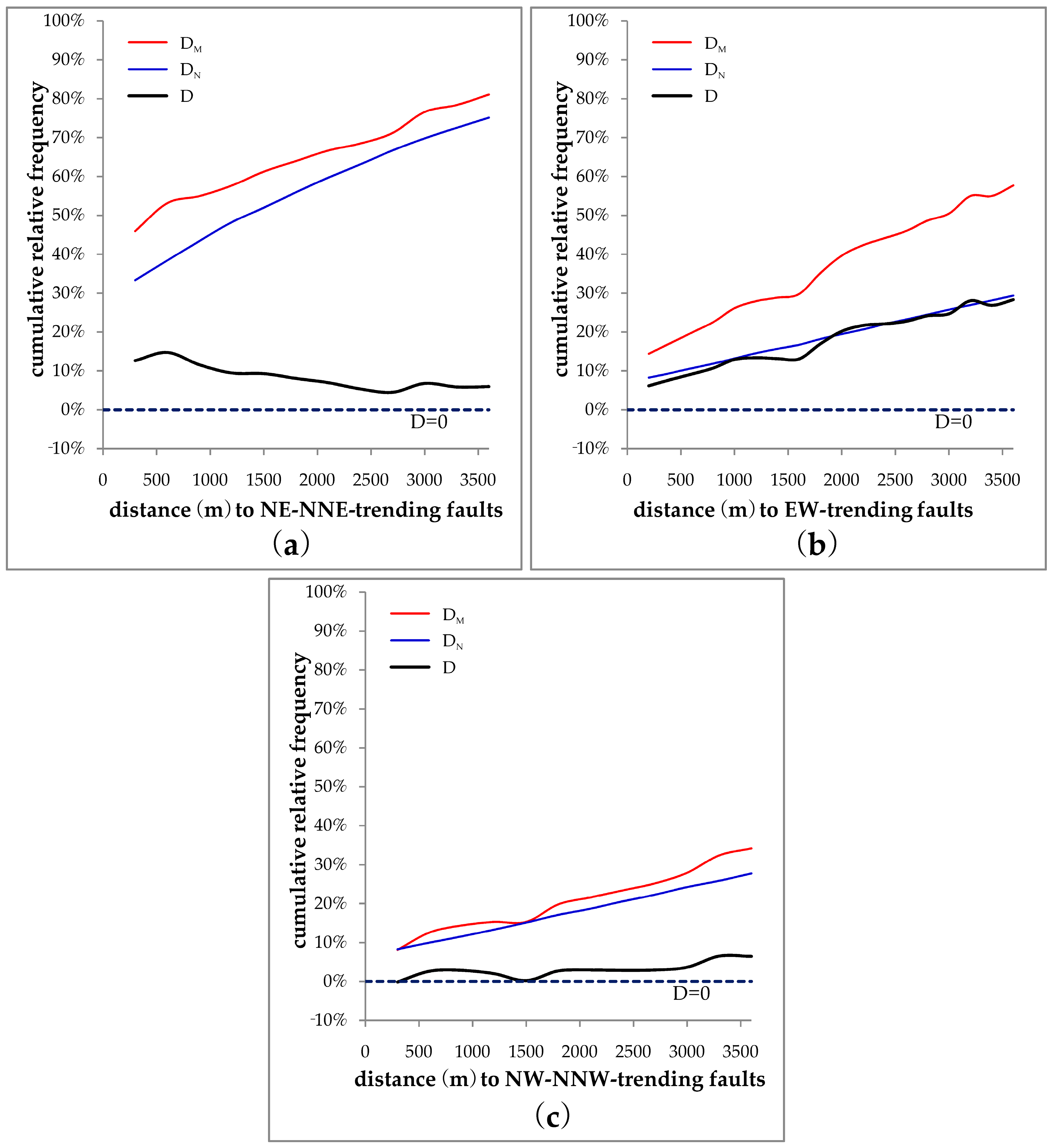
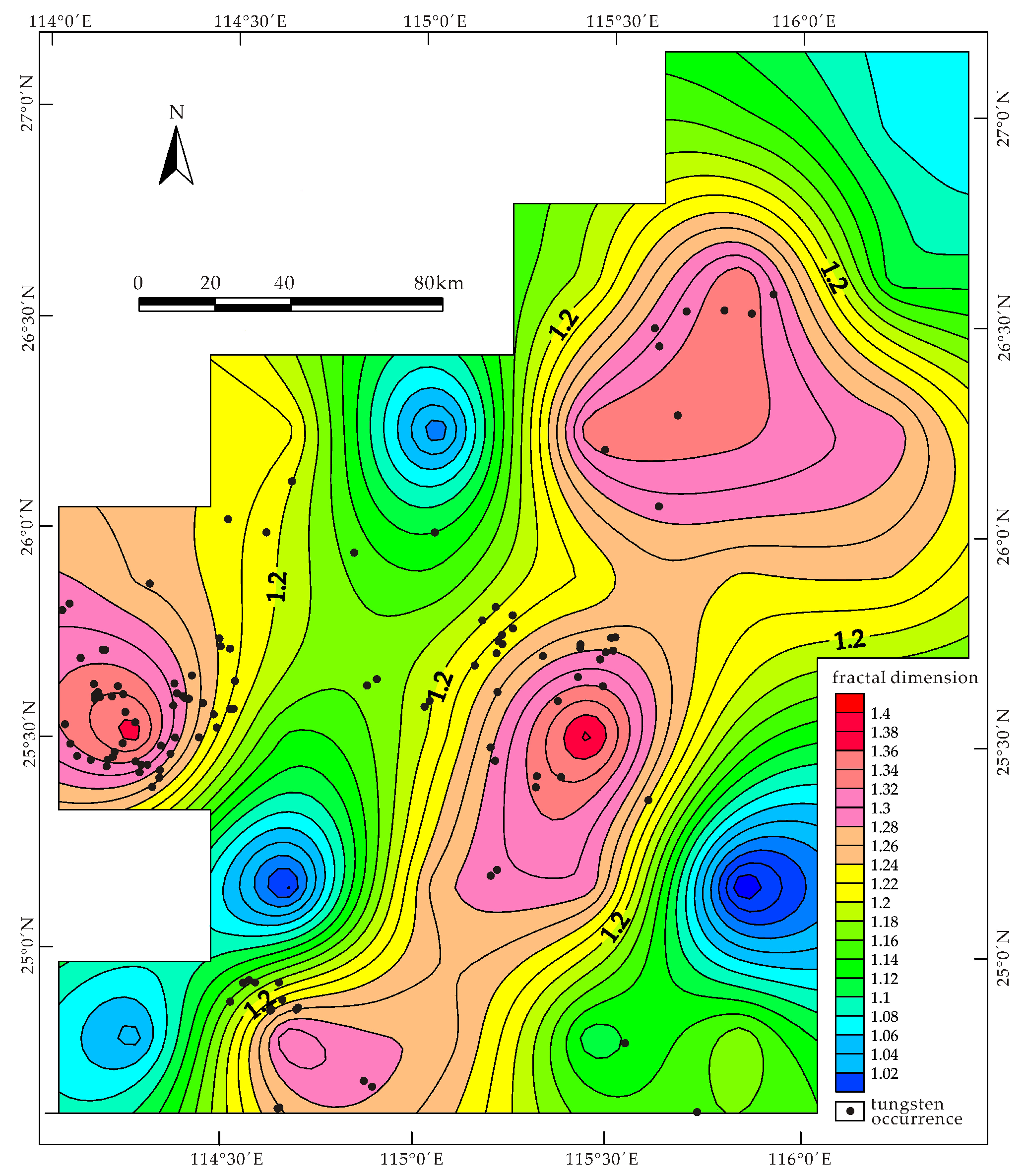
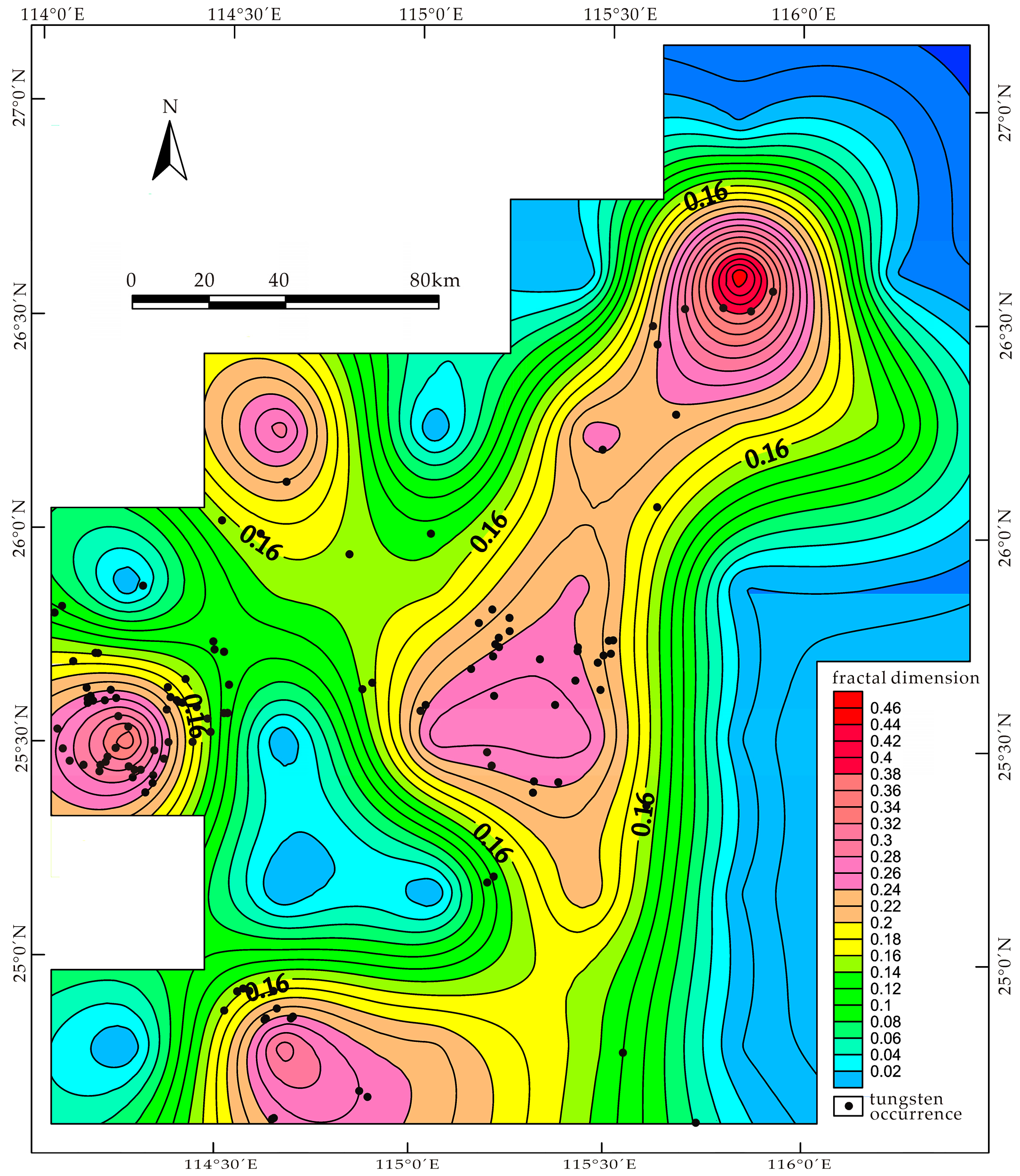
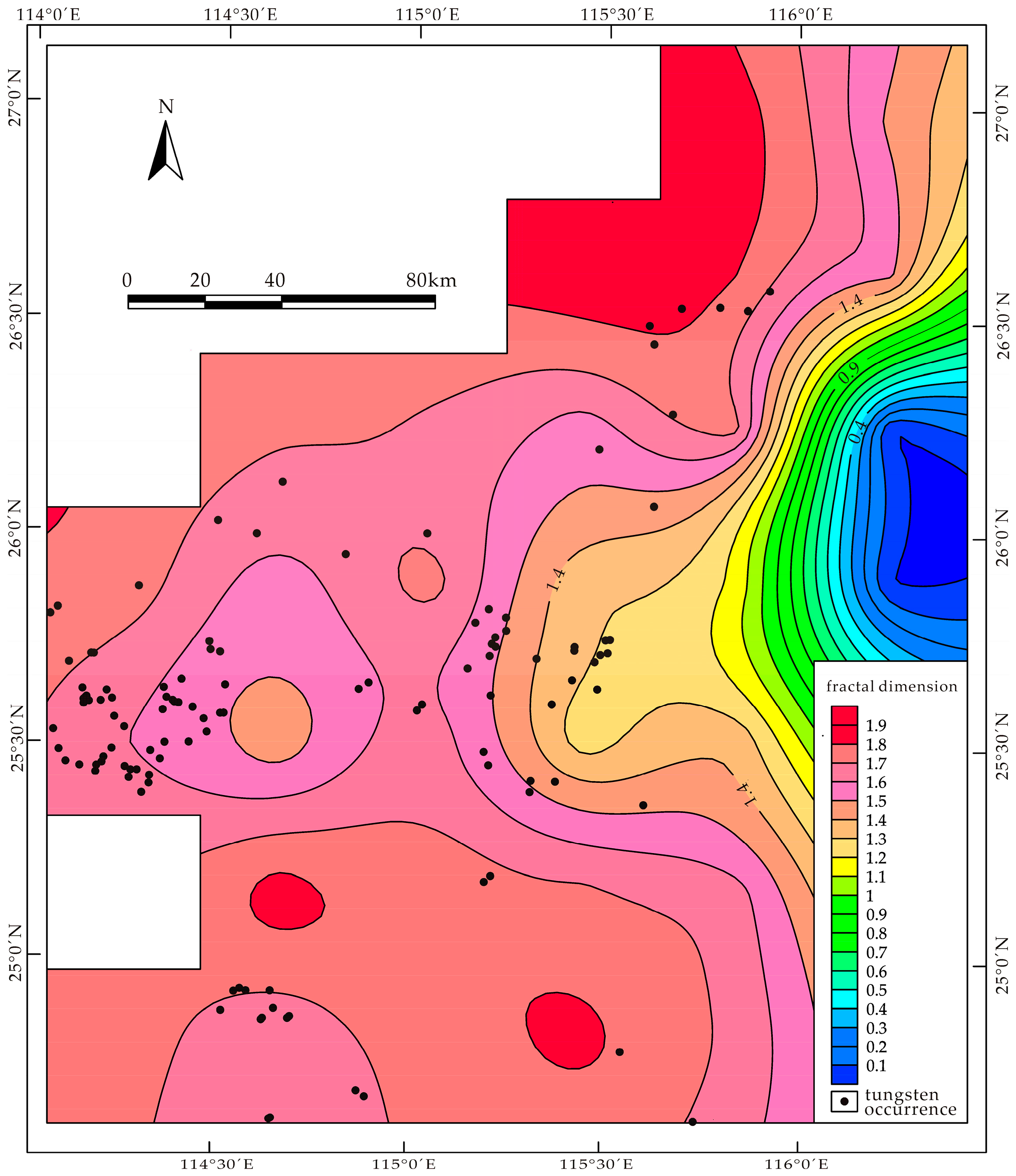
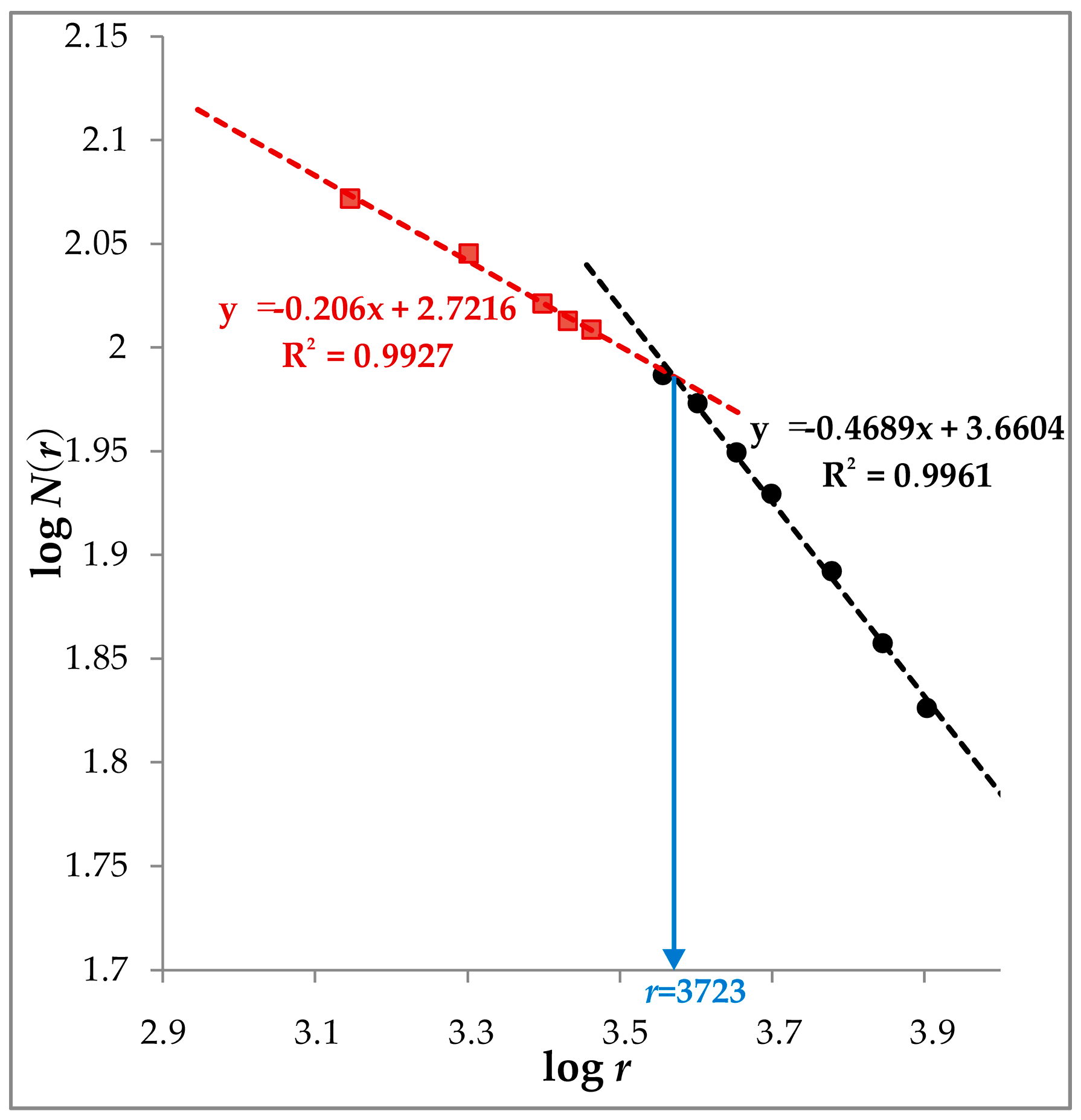
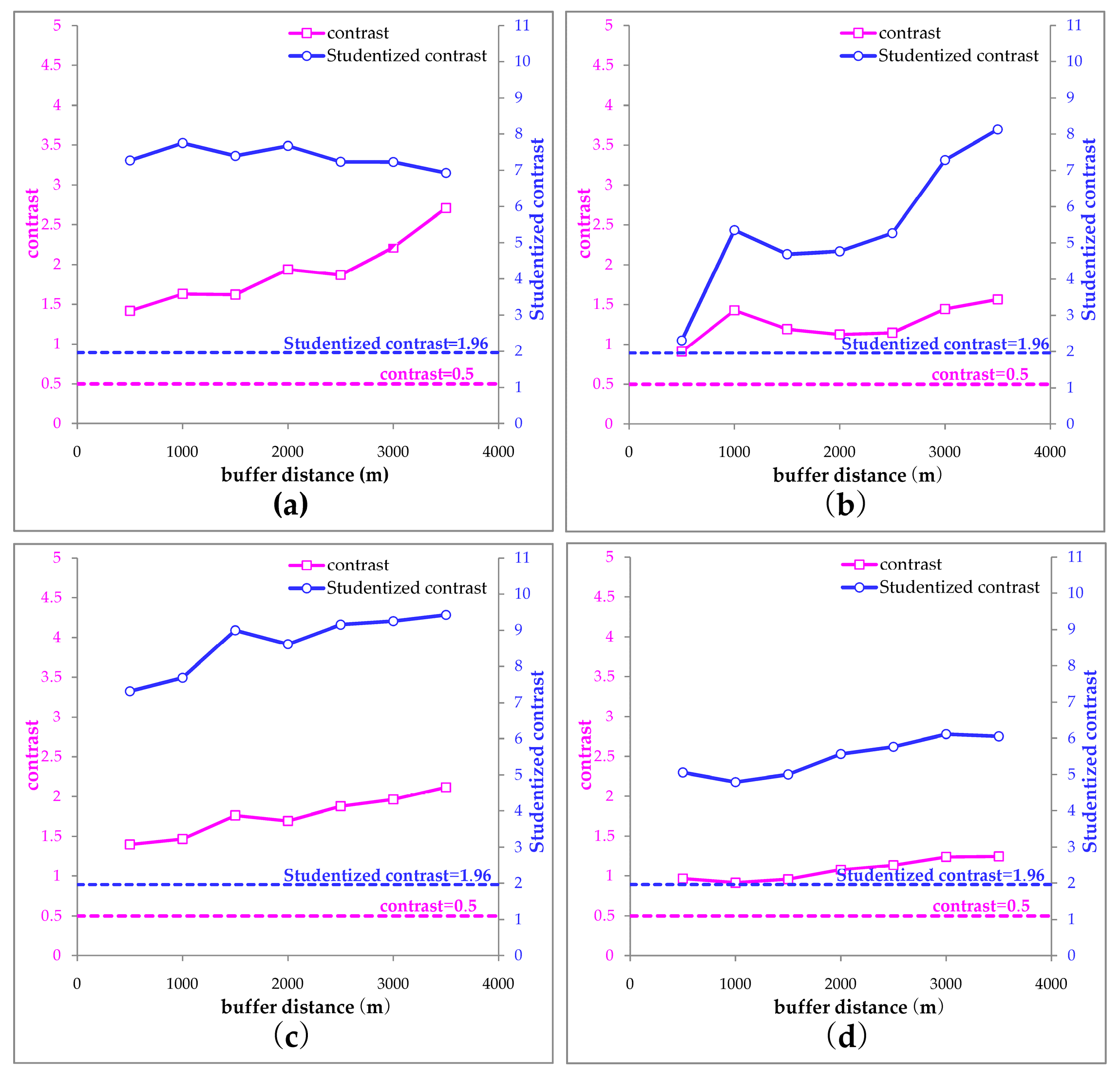

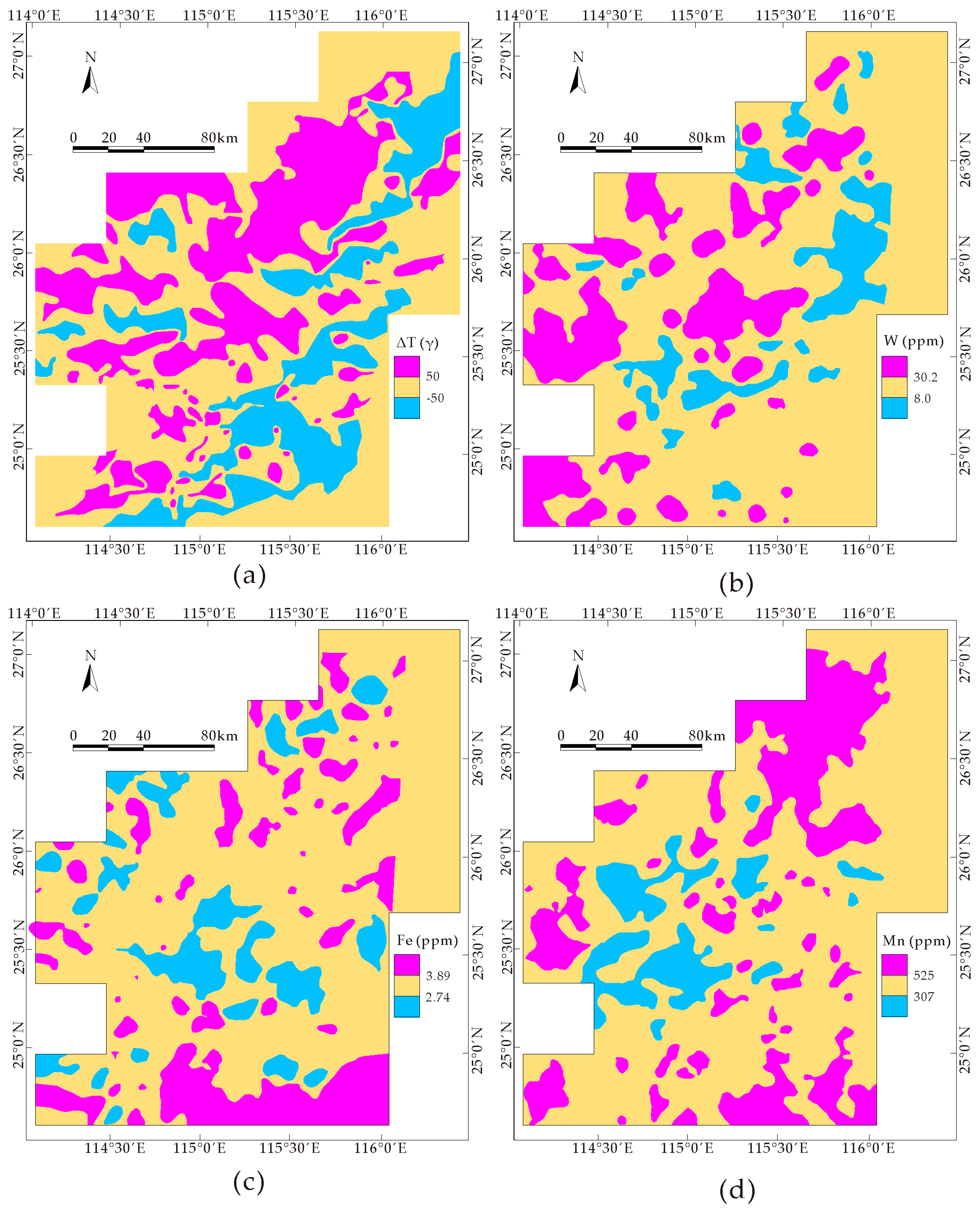

| Region ID | Fault | Fault Intersection | Yanshanian Granites | Tungsten Occurrences | |||
|---|---|---|---|---|---|---|---|
| DB | R2 | DB | R2 | DB | R2 | ||
| 01 | 1.150 | 0.9991 | Null | Null | 1.846 | 0.9993 | 0 |
| 02 | 1.074 | 0.9951 | Null | Null | 1.476 | 0.9915 | 0 |
| 03 | 1.188 | 0.9939 | Null | Null | 1.859 | 0.9999 | 2 |
| 04 | 1.341 | 0.9938 | 0.468 | 0.9164 | 1.799 | 0.9988 | 4 |
| 05 | 1.110 | 0.9940 | Null | Null | 1.521 | 0.9971 | 0 |
| 06 | 1.230 | 0.9989 | 0.293 | 0.9852 | 1.712 | 0.9985 | 1 |
| 07 | 1.002 | 0.9943 | Null | Null | 1.682 | 0.9967 | 0 |
| 08 | 1.338 | 0.9980 | 0.249 | 0.9683 | 1.545 | 0.9976 | 2 |
| 09 | 1.326 | 0.9998 | 0.190 | 0.9212 | 1.729 | 0.9976 | 1 |
| 10 | 1.292 | 0.9996 | 0.134 | 0.8369 | Null | Null | 0 |
| 11 | 1.259 | 0.9998 | Null | Null | 1.769 | 0.9994 | 6 |
| 12 | 1.194 | 0.9997 | 0.149 | 0.8895 | 1.553 | 0.9984 | 6 |
| 13 | 1.148 | 0.9996 | 0.151 | 0.8435 | 1.737 | 0.9993 | 9 |
| 14 | 1.221 | 0.9997 | 0.245 | 0.9560 | 1.322 | 0.9930 | 7 |
| 15 | 1.233 | 0.9992 | Null | Null | 1.159 | 0.9636 | 0 |
| 16 | 1.237 | 1.0000 | Null | Null | Null | Null | 0 |
| 17 | 1.373 | 0.9993 | 0.360 | 0.8976 | 1.602 | 0.9982 | 41 |
| 18 | 1.138 | 0.9995 | Null | Null | 1.429 | 0.9950 | 5 |
| 19 | 1.209 | 0.9996 | 0.273 | 0.6807 | 1.639 | 0.9981 | 8 |
| 20 | 1.389 | 0.9991 | 0.268 | 0.8691 | 1.240 | 0.9848 | 8 |
| 21 | 1.164 | 0.9996 | Null | Null | 1.364 | 0.9547 | 0 |
| 22 | 0.969 | 0.9915 | Null | Null | 1.847 | 0.9996 | 0 |
| 23 | 1.274 | 0.9983 | Null | Null | 1.786 | 0.9996 | 2 |
| 24 | 1.292 | 0.9987 | 0.216 | 0.8553 | 1.719 | 0.9984 | 0 |
| 25 | 0.938 | 0.9977 | Null | Null | 1.633 | 0.9987 | 0 |
| 26 | 1.031 | 0.9964 | Null | Null | 1.739 | 0.9977 | 0 |
| 27 | 1.319 | 0.9998 | 0.313 | 0.9063 | 1.601 | 0.9958 | 12 |
| 28 | 1.276 | 0.9998 | 0.225 | 0.8815 | 1.749 | 0.9994 | 2 |
| 29 | 1.106 | 0.9970 | 0.151 | 0.8435 | 1.814 | 0.9998 | 1 |
| 30 | 1.175 | 0.9990 | Null | Null | 1.668 | 0.9981 | 1 |
| Geological Feature | Optimum Buffer/m | W+ | W− | C | Cs |
|---|---|---|---|---|---|
| Faults | 3500 | 0.632 | −2.075 | 2.707 | 6.928 |
| Fault intersections | 3500 | 1.135 | −0.429 | 1.564 | 8.127 |
| Yanshanian granites | 3500 | 0.998 | −1.120 | 2.117 | 9.420 |
| Magnetic anomalies | 3000 | 0.587 | −0.655 | 1.243 | 6.109 |
| W anomalies | 1000 | 1.545 | −3.093 | 4.638 | 9.101 |
| Fe anomalies | 1500 | 0.471 | −0.185 | 0.656 | 3.284 |
| Manganese anomalies | 3000 | 0.919 | −1.274 | 2.194 | 9.030 |
© 2017 by the authors. Licensee MDPI, Basel, Switzerland. This article is an open access article distributed under the terms and conditions of the Creative Commons Attribution (CC BY) license (http://creativecommons.org/licenses/by/4.0/).
Share and Cite
Sun, T.; Wu, K.; Chen, L.; Liu, W.; Wang, Y.; Zhang, C. Joint Application of Fractal Analysis and Weights-of-Evidence Method for Revealing the Geological Controls on Regional-Scale Tungsten Mineralization in Southern Jiangxi Province, China. Minerals 2017, 7, 243. https://doi.org/10.3390/min7120243
Sun T, Wu K, Chen L, Liu W, Wang Y, Zhang C. Joint Application of Fractal Analysis and Weights-of-Evidence Method for Revealing the Geological Controls on Regional-Scale Tungsten Mineralization in Southern Jiangxi Province, China. Minerals. 2017; 7(12):243. https://doi.org/10.3390/min7120243
Chicago/Turabian StyleSun, Tao, Kaixing Wu, Lingkang Chen, Weiming Liu, Yun Wang, and Cisheng Zhang. 2017. "Joint Application of Fractal Analysis and Weights-of-Evidence Method for Revealing the Geological Controls on Regional-Scale Tungsten Mineralization in Southern Jiangxi Province, China" Minerals 7, no. 12: 243. https://doi.org/10.3390/min7120243





